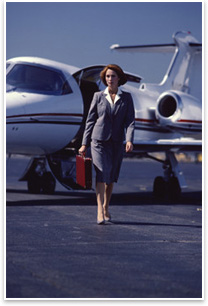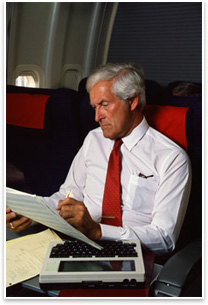| |
 Business Travel Made Easy Business Travel Made Easy
by Christi Youd
Professional organizer
How do you . . . avoid time delays and stress to get to your business meetings ready to work.
Summary: Cancelled flights … lost luggage … presentation programs that won’t run … the list of potential business trip challenges is virtually endless. In fact, when it comes to business travel, it seems that problems and delays are the norm, not the exception. The key is to be prepared for anything that comes your way. Only then will arriving at your destination be as simple as your morning drive into the office.
Unfortunately, most business travelers are unprepared for even the smallest of travel glitches. And although they may have made numerous business trips in the past, each with its own problem or two, people still don’t plan for setbacks when the next trip rolls around. As a result, they get frustrated when traveling and view business trips as a hassle they wish they could avoid.
If you have to travel for business, take the approach that everything will go wrong. That way you’re prepared to handle whatever comes your way and no challenge will derail your business plans. Following are the key steps to take before, during, and after a trip to make business travel as stress-free as possible.
1.  Your pre-flight preparations Your pre-flight preparations
- Create your travel binder. This is a small binder (5” x 11”) that will hold all your travel document essentials. In your binder include your airline ticket (or electronic ticketconfirmation), photo identification, passport (if needed), expense log, receipt envelope or pocket, cash, passes or membership cards, and your frequent flyer or frequent stay identification numbers. To minimize the number of frequent guest cards you need to carry, laminate a single card that has all of your frequent flyer and frequent stay identification numbers and information. Keep your travel binder with you at all times, in an outside pocket of your carry-on bag.
- When you choose your flight, never reserve the last flight scheduled before you need to be at your destination, even if that means arriving at your destination a day early. Why? Because you need to plan that something will go wrong with your flight and you’ll need to catch the next flight out. If the meeting or event you’re attending is critical, then make sure you have two flight times you can fall back on. Remember, flights get cancelled, grounded, and delayed every day. You need a backup so you can still make it to your destination on time.
- If you’ll be making a presentation using PowerPoint or some other software program, prepare a backup of your presentation. For example, you could carry a flash drive around your neck, pack a CD in your carry on luggage, burn a copy on the hard drive of your laptop, pack a hard copy in your checked luggage, or upload an electronic copy online so you can download it should you need it. At the minimum, have at least two presentation backup options. If it’s a vital presentation, have three or four backup options.
- Pack light enough that you can personally carry all your luggage without assistance. You may not need to carry it all by yourself, but you want to be able to should the need arise.
2.  Travel-day essentials Travel-day essentials
- When you travel, always wear the clothing you plan to wear for your presentation or meeting. If needed, you can get the clothes laundered that evening at the hotel. But because luggage delays are common, you don’t want to have to meet that big client wearing jeans and a t-shirt. As an added bonus, the more professional you dress when traveling, the higher your chances of being bumped up to first class.
- Label everything, even your carry-on luggage. Count on checked luggage not returning with you if you don’t have your label and contact information on it. And always assume that you’ll get separated from your carry-on bag for some reason. Make it as easy as possible for all your belongings to find their way back to you. For security purposes, label everything with your business information rather than your home information.
- Check with your airline for any travel or security measures. Each airline has different guidelines in terms of number of checked and carry-on bags allowed, weight and/or size limitations for baggage, and restrictions on what items you can bring aboard the plane. Also check the TSA Web site for any updated security checkpoint guidelines.
- Plant a cash reserve in several different locations: on your body, in your travel binder, in your carry on, etc. Things often get lost or stolen, and you don’t want to be stranded without any money. Also remember to bring small bills for tips as well as larger bills for greater expenses.
- Allow ample time for you to go from your home to your scheduled flight. Calculate how long your drive to the airport will be, including traffic delays. Double the amount of time you think it will take. Calculate how long it will take you to shuttle from the parking area to the airport entrance. Double the amount of time you think it will take. Calculate how long it will take you to get through security and to your gate. Double the amount of time you think it will take. Plan on things going wrong and schedule time for delays. If you end up being early and have lots of time to kill before your flight, bring some work with you that you can complete at the airport or on your flight.
 3. Post-trip planning 3. Post-trip planning
- Begin preparing for your next business trip as soon as you return from the current one. Restock all your travel size toiletry containers so you’re ready for your next flight. If you wait until the next trip to prepare, chances are that in your rush to get everything done, you’ll forget some essential items.
- Clean out your travel binder and have it ready for the next trip. Sort through your receipts, and complete and submit your expense log. Restock your travel binder with any updated papers or cards, and replenish your cash reserve.
- Do any promised follow-up or delegation the day you arrive back at the office. If you wait a few days until you’re “back in the groove” of everyday work, you’ll get sidetracked and will forget to complete the tasks you said you’d do.
Fly through the challenges of air travel
Realize that you can use these same suggestions for personal travel, thus making your vacations truly relaxing without the customary horror stories of airline travel. All it takes is a little planning and forethought on your part. In the end, airline travel, whether for business or pleasure, doesn’t have to be the headache so many people make it out to be. By simply following a few guidelines before, during, and after your trip, you can make any travel experience stress-free and enjoyable.
|
|



 Your pre-flight preparations
Your pre-flight preparations Travel-day essentials
Travel-day essentials 3. Post-trip planning
3. Post-trip planning